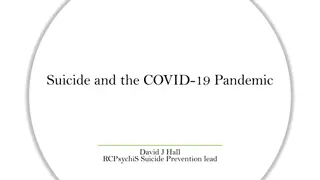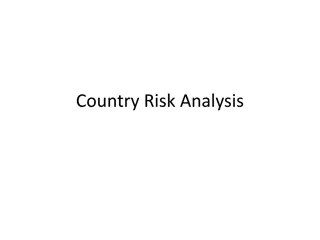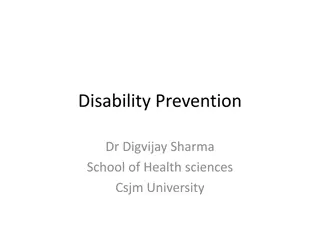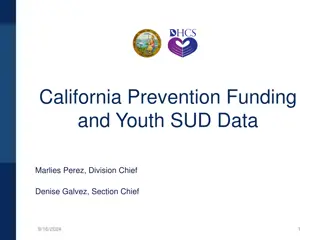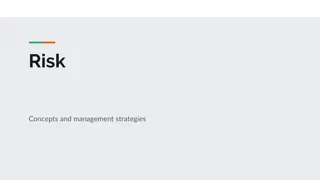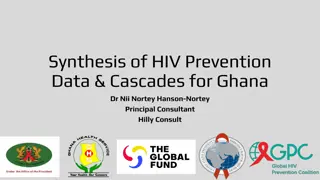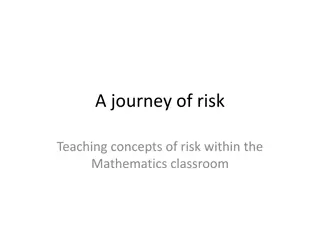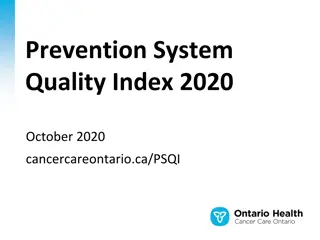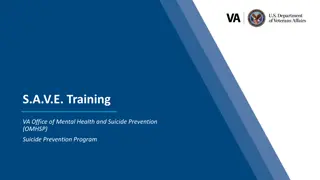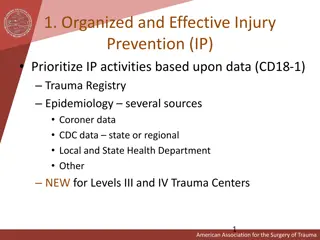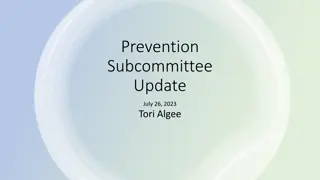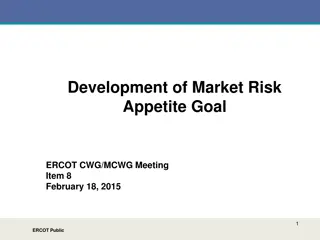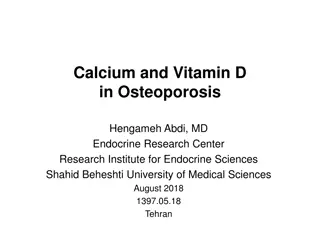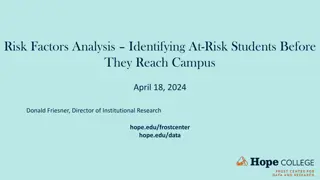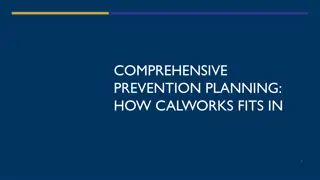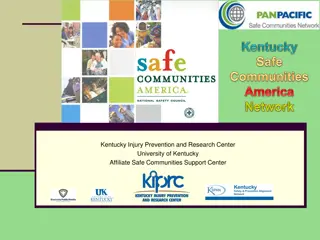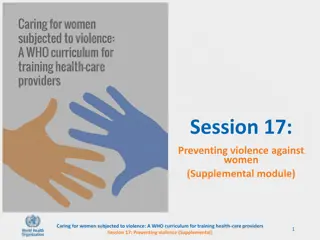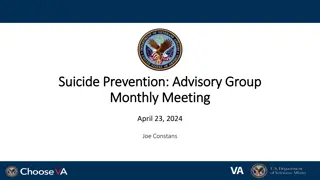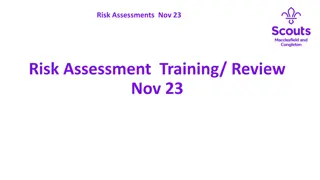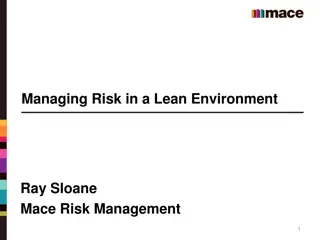Comprehensive Overview of Security Risk Analysis and Management
Explore the essential aspects of security risk analysis and management, including risk identification, assessment, and control techniques within an Information Security (InfoSec) context. Learn about the purpose of risk management, steps involved in a risk management plan, asset identification and c
0 views • 22 slides
Risk Management in Environmental Geography and Disaster Management
Risk management in environmental geography and disaster management involves assessing the potential losses from hazards, evaluating vulnerability and exposure, and implementing strategies to mitigate risks. It includes calculating risk, dealing with risk through acceptance, avoidance, reduction, or
2 views • 10 slides
Introduction to Flood Risk Assessment with HEC-FDA Overview
This presentation delves into flood risk assessment using HEC-FDA software, covering topics such as defining flood risk, components of uncertainty, consequences of flood risk, and methods to assess flood risk including hydrology, hydraulics, geotechnical, and economics. It explores the intersection
7 views • 39 slides
Progress in Prevention and Health Inequalities - Annual Report 2023-24
The Prevention and Health Inequalities Team at BOB ICB is dedicated to enhancing prevention efforts and reducing health inequalities across their population and communities. Key achievements include setting up inpatient and maternity tobacco dependency treatment services, establishing prevention net
0 views • 14 slides
Suicide Risk and Prevention During the COVID-19 Pandemic
The COVID-19 pandemic has raised concerns about potential increases in suicide rates due to its economic impacts and social disruptions. While there is a focus on suicide prevention efforts, the exact effect of the pandemic on suicide rates remains unclear. Initiatives such as Suicide Prevention Act
1 views • 10 slides
Agricultural Risk Management in the Face of Natural Disasters
Exploring the impact of natural disasters on agricultural economics, this content delves into the challenges faced by farmers and the approaches available for managing risks. From analyzing the Billion-Dollar Disasters in the US to discussing private and public risk management provisions, the conten
4 views • 20 slides
Country Risk Analysis in International Business
Country risk analysis is crucial for multinational corporations (MNCs) to assess the potential impact of a country's environment on their financial outcomes. It includes evaluations of political and economic risks in foreign operations. Sovereign risk, political risk characteristics, and factors are
1 views • 61 slides
Project Risk Management Fundamentals: A Comprehensive Overview
Project risk management involves minimizing potential risks and maximizing opportunities through processes such as risk management planning, risk identification, qualitative and quantitative risk analysis, risk response planning, and risk monitoring and control. Quantitative risk analysis assesses t
0 views • 41 slides
Citizen Security and Justice Programme: Case Management for Violence Prevention
The Citizen Security and Justice Programme (CSJP) under the Ministry of National Security in Jamaica focuses on violence prevention through case management, risk assessment, and treatment plans. By targeting at-risk youth and implementing services such as education, psychological support, and peer a
0 views • 16 slides
Disability Prevention and Levels of Prevention
Disability prevention involves efforts to eliminate or reduce the causes and severity of disabilities. It can be achieved through primary, secondary, and tertiary prevention strategies, aiming to prevent risk factors that cause impairment and promote overall well-being. Primary prevention focuses on
2 views • 21 slides
Comprehensive Student Support Program for Mental Health and Wellness
Providing a wide range of no-cost services to students and families, the program focuses on drug/alcohol prevention, suicide prevention, character building, bullying prevention, and more. Through initiatives like teaching Botvin Life Skills, implementing suicide prevention curriculum, and offering s
1 views • 5 slides
POLLUTION PREVENTION: A Closer Look at Environmental Initiatives in Oklahoma
Explore the evolution and implementation of pollution prevention measures in Oklahoma, focusing on statutory directives, recent activities, recycling efforts, tax credits, and more. The Pollution Prevention Act of 1990 plays a crucial role in reducing environmental hazards through the reduction of p
0 views • 31 slides
Prevention and Care of Airborne Infections in TB/HIV Settings
In this session, participants will learn the importance of infection prevention and control in TB/HIV care, levels of prevention in airborne infections, strategies to prevent TB transmission in healthcare settings, and patient management steps to prevent TB transmission. The spread of TB, risks of t
0 views • 20 slides
Youth Substance Abuse Prevention Funding in California
California utilizes Substance Abuse Prevention and Treatment Block Grant (SABG) funding to support primary prevention services for youth. Approximately $40 million is distributed annually to 58 counties for strategic prevention planning based on local needs assessments. Initiatives like the Strategi
0 views • 18 slides
Risk Concepts and Management Strategies in Finance
Explore the essential concepts of risk in finance, such as risk definition, risk profiles, financial exposure, and types of financial risks. Learn about risk vs. reward trade-offs, identifying risk profiles, and tools to control financial risk. Understand the balance between risk and return, and the
0 views • 18 slides
Risk and Return Assessment in Financial Management
This comprehensive presentation explores the intricacies of risk and return assessment in the realm of financial management. Delve into understanding risk concepts, measuring risk and return, major risk categories, and the impact of risk aversion on investment decisions. Gain insights into the manag
2 views • 62 slides
Risk Management and Security Controls in Research Computing
The European Grid Infrastructure (EGI) Foundation conducts risk assessments and implements security controls in collaboration with the EOSC-hub project. The risk assessments involve evaluating threats, determining likelihood and impact, and recommending treatment for high-risk threats. Results from
1 views • 13 slides
Risk Management & MPTF Portfolio Analysis at Programme Level for UN Somalia
This session delves into the world of risk management and portfolio analysis at the programme/project level, specifically focusing on the Risk Management Unit of the United Nations Somalia. It covers enterprise risk management standards, planned risk management actions, the role of RMU, joint risk m
0 views • 30 slides
Alcohol and Cancer Risk: Understanding the Links
Alcohol consumption is linked to an increased risk of various cancers, including mouth, throat, esophagus, breast, liver, and colorectal cancers. Factors such as ethanol, acetaldehyde, nutrient absorption, estrogen levels, and liver cirrhosis play a role in this risk. Even light drinking can elevate
0 views • 17 slides
Comprehensive Overview of HIV Prevention Strategies and Interventions
This synthesis covers the importance of monitoring progress in HIV prevention through data cascades, the need for standardized frameworks, promoting effective HIV prevention programs in diverse social contexts, and the key pillars of combination HIV prevention strategies. It also outlines various HI
0 views • 40 slides
Risk Concepts in the Mathematics Classroom
Risk is a concept integral to decision-making in various aspects of life. This resource explores how risk is defined in the real world, its relevance in the classroom, and strategies for teaching risk literacy to students. It delves into the multiple definitions of risk, risk analysis, and the emoti
0 views • 62 slides
Cancer Prevention System Quality Index 2020: Addressing Cancer Risk Factors in Ontario
The Prevention System Quality Index 2020 from CancerCareOntario provides a detailed report on indicators, policies, and programs to address cancer risk factors in Ontario. It offers evidence and data to aid in the implementation of effective cancer prevention measures by various agencies. The report
0 views • 35 slides
Suicide Prevention and Awareness Training
This training program by the VA Office of Mental Health and Suicide Prevention (OMHSP) provides valuable insights on suicide prevention, including common myths and realities, identifying at-risk individuals, and steps to take. Learn about the scope of suicide in the U.S., how to recognize Veterans a
0 views • 33 slides
Effective Strategies for Injury Prevention in Trauma Centers
Organized and data-driven injury prevention activities are crucial in trauma centers. Community partnerships, evidence-based reviews, designated injury prevention coordinators, and involvement of trauma personnel are key elements for successful injury prevention. Targeting contributing factors like
0 views • 20 slides
Prevention Subcommittee Update - July 26, 2023 Review
The Prevention Subcommittee Update held on July 26, 2023, highlighted key topics including an introduction, strategic plan prioritization, insights from subject matter experts, and discussions on the Prevention Center and workshops. The subcommittee comprises talented preventionist commissioners and
0 views • 6 slides
Assessment of HIV Prevention Programme Needs and Barriers in Ghana
Conduct a data-driven assessment of HIV prevention programme needs and barriers in Ghana based on the Ghana Road Map Baseline Survey components. Evaluate the country's preparedness in addressing HIV epidemic patterns and prevention response analysis. Identify key barriers hindering HIV prevention ef
0 views • 11 slides
Building Disaster Resilient Societies: Progress, Challenges, and the Way Forward
The discourse delves into the current landscape of disaster risk, the status of the Sendai Framework Targets, global DRR challenges identified during the Mid-term Review Process, and the proposed way forward for enhancing disaster resilience. It emphasizes shifting focus towards prevention and risk
0 views • 7 slides
Organizational Risk Appetite and Tolerance
Explore the development of market risk appetite goals and how to define and establish organizational risk tolerance. Learn about the Classic Simplified View of Risk Tolerance and different methods to determine risk appetite. Discover the importance of assessing market risk impact and aligning risk t
0 views • 8 slides
Developing a Risk Appetite Culture: Importance and Framework
Risk management plays a critical role in the success of corporations, with strategy and risk being intertwined. This presentation delves into definitions of key terms such as risk appetite, the Risk Appetite Cycle, characteristics of a well-defined risk appetite, and the importance of expressing ris
0 views • 31 slides
Update on Calcium and Vitamin D Supplementation in Osteoporosis
The study reviews the benefits and risks of calcium and vitamin D supplementation for bone health. It discusses the impact on bone loss, fracture prevention, fall prevention, and cardiovascular risks. Evidence suggests that increasing calcium intake may have limited effects on bone mineral density a
0 views • 30 slides
Security Planning and Risk Management Overview
This content provides an in-depth exploration of managing risk, security planning, and risk appetite in the context of cybersecurity. It covers essential concepts such as risk management process, threat types, risk analysis strategies, vulnerability assessment, and risk mitigation techniques. The ma
1 views • 73 slides
Situational Crime Prevention Strategies
Situational crime prevention strategies aim to reduce crime by altering environmental conditions, influencing offender decisions, and targeting crime opportunities. Primary prevention focuses on modifying physical and social environments, while secondary prevention aims to identify potential offende
1 views • 31 slides
Risk Factors Analysis: Identifying At-Risk Students Before They Reach Campus
Risk Factors Analysis aims to identify students at risk of attrition before they even arrive on campus by evaluating academic, financial, minority, and first-generation factors. The method involves choosing specific risk factors, tracking historical prevalence, calculating relative risk, and predict
0 views • 15 slides
California's Family First Prevention Services Program
California's Family First Prevention Services Program, established under the Family First Prevention Services Act of 2018, aims to provide evidence-based prevention and trauma-informed services to children and youth at risk of entering foster care. The program leverages a comprehensive plan that inc
0 views • 21 slides
Kentucky Injury Prevention and Research Center - Promoting Safe Communities
The Kentucky Injury Prevention and Research Center (KIPRC) at the University of Kentucky focuses on reducing the burden of injuries across the state. Founded in 1994, KIPRC works on surveillance, data analysis, and prevention of injuries related to falls, poisonings, fires, motor vehicles, and viole
0 views • 21 slides
Risk and Protective Factors in Preventing Violence Against Women
Violence against women is preventable, and understanding risk and protective factors is crucial in developing effective prevention strategies. This WHO curriculum focuses on enhancing protective factors, minimizing risk, and implementing prevention programs to address violence against women. It high
0 views • 22 slides
Suicide Prevention Advisory Group Meeting - April 23, 2024
The Suicide Prevention Advisory Group held its monthly meeting on April 23, 2024, discussing critical research priorities and key areas of focus for suicide prevention efforts. The meeting agenda included reviewing priority setting processes, analyzing survey results, and determining key research ar
0 views • 22 slides
Comprehensive Risk Assessment Training Overview
In this risk assessment training session held on November 23, participants reviewed the process of writing and reviewing risk assessments to enhance the quality of assessments for safer scouting experiences. The training aimed to improve leaders' skills and confidence in risk assessment practices wh
0 views • 37 slides
Risk Terrain Modeling for Crime Prevention in New York City
Risk Terrain Modeling (RTM) is a spatial risk analysis tool used to identify and model crime risks based on landscape features, helping inform policing strategies. Explore its utility, relevant theoretical background, past applications, risk factors, and methodology in the context of crime preventio
0 views • 15 slides
Managing Risk in a Lean Environment: Connecting Lean Construction with Risk Reduction
This content explores the connection between Lean Construction and risk management, focusing on how Lean principles can help reduce risk and improve risk management practices in construction projects. It delves into the common objectives of Risk Management and Lean Construction, highlighting key opp
0 views • 11 slides




